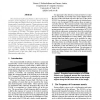Free Online Productivity Tools
i2Speak
i2Symbol
i2OCR
iTex2Img
iWeb2Print
iWeb2Shot
i2Type
iPdf2Split
iPdf2Merge
i2Bopomofo
i2Arabic
i2Style
i2Image
i2PDF
iLatex2Rtf
Sci2ools
102
Voted
ICPR
2000
IEEE
2000
IEEE
Novelty Detection in Airframe Strain Data
The structural health of airframes is often monitored by analysis of the frequency of occurrence matrix (FOOM) produced after each flight. Each cell in the matrix records a stress event of a particular severity. These matrices are used to determine how much of the aircraft's life has been used up in each flight. Unfortunately, the sensors that produce this data are subject to degradation themselves, resulting in corruption of FOOMs. This paper reports a method of automating detection of sensor faults. It is the only known method that is capable of detecting such faults. The method is in essence a dimensionality reduction algorithm coupled to a novelty detection algorithm that produce measures of unusual counts of stress events at the level of the individual cell and unusual distributions of counts over the entire FOOM. Cell-level error is detected using a probability threshold and a sum of standard deviations. FOOM-level error is detected using a novel application of the Eigenfac...
Computer Vision | Dimensionality Reduction Algorithm | Eigenface Algorithm | ExpectationMaximisation Algorithm | ICPR 2000 |
| Added | 09 Nov 2009 |
| Updated | 09 Nov 2009 |
| Type | Conference |
| Year | 2000 |
| Where | ICPR |
| Authors | Simon J. Hickinbotham, James Austin |
Comments (0)

